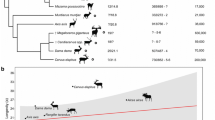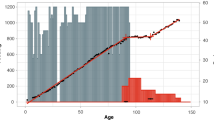Abstract
Growth in mammals often implies differences in body proportions and tissue development more or less characteristic for different age periods and ontogenetic stages. Mouth morphology is an important functional trait in herbivores, as it may determine both maximal intake rate and possibly level of selectivity. An untested hypothesis is that since individual bones within the skeleton are retarded in growth and development in proportion to their growth intensity at each time interval during periods of restricted nutritional supply, this may potentially affect ultimate skeletal proportions. We analysed data on mandible proportions (anterior:total) of 62 fetuses collected at different stages of growth and 16 776 red deerCervus elaphus Linnaeus, 1758 hinds from 0 to 26 years of age and 24026 males from 0 to 22 years of age harvested during autumns 1965–2001 along the west coast of Norway. At the fetal stage, the mandible proportion was negatively related to body weight and, therefore, declined with age of the fetus. The anterior part of the mandible was initially longer than the posterior part; the mandible proportion was between 0.75–0.8 at the fetal stage, but declined with increasing age. The relationship between mandible proportion and weight was strong for calves, but decreased with increasing age, and the relationship was almost flat when reaching 5 years of age. From 5 years, the anterior and posterior part of the mandible was approximately equal in length and this mandible proportion (0.50–0.51), which was unrelated to weight, remained stable for the rest of the life in both hinds and stags. After they were fully-grown, early conditions (cohort density and climate as measured by the North Atlantic Oscillation) had no measurable effect on ultimate mandible proportions after the effect of body weight was removed.
Similar content being viewed by others
References
Ahlén I. 1965. Studies on the red deer,Cervus elaphus L., in Scandinavia. Swedish Wildlife Research 3: 177–376.
Albon S. D. and Langvatn R. 1992. Plant phenology and the benefits of migration in a temperate ungulate. Oikos 65: 502–513.
Azorit C., Analla M. and Munoz-Cobo J. 2003. Variation of mandible size in red deerCervus elaphus hispanicus from southern Spain. Acta Theriologica 48: 221–228.
Bell R. H. V. 1971. A grazing ecosystem in the Serengeti. Scientific American 225: 86–89.
Cochran W. G. and Rubin D. B. 1973. Controlling bias in observational studies: a review. Sankhya 35: 417–446.
Davies A. S., Tan G. Y. and Broad T. E. 1984. Growth gradients in the skeleton of cattle, sheep and pigs. Journal of Veterinary Medicin C Anatomy Histology Embryology 13: 222–230.
Demment M. W. and Van Soest P. J. 1985. A nutritional explanation for body-size patterns of ruminant and nonruminant herbivores. The American Naturalist 125: 641–672.
Dzięciołowski R. 1970. Relations between the age and size of red deer in Poland. Acta Theriologica 15: 253–268.
Forchhammer M. C., Stenseth N. C., Post E. and Langvatn R. 1998. Population dynamics of Norwegian red deer: density-dependence and climatic variation. Proceedings of the Royal Society of London, Series B 265: 341–350.
Gaillard J.-M., Festa-Bianchet M. and Yoccoz N. G. 1998. Population dynamics of large herbivores: variable recruitment with constant adult survival. Trends in Ecology and Evolution 13: 58–63.
Gaillard J.-M., Loison A., Toigo C., Delorme D. and Van Laere G. 2003. Cohort effects and deer population dynamics. Ecoscience 10: 412–420.
Geist V. 1974. On the relationship of social evolution and ecology in ungulates. American Zoologist 14: 205–220.
Gordon I. J. and Illius A. W. 1988. Incisor arcade structure and diet selection in ruminants. Functional Ecology 2: 15–22.
Hamlin K. L., Pac D. F., Sime C. A., DeSimone R. M. and Dusek G. L. 2000. Evaluating the accuracy of ages obtained by two methods for Montana ungulates. The Journal of Wildlife Management 64: 441–449.
Hammond J. 1932. Growth and development of mutton qualities in the sheep. A survey of the problems involved in meat production. Oliver and Boyd, Edinburgh: 1–597.
Hammond J. 1940. Some factors affecting the quality and composition of meat. Chemistry and Industry 29: 521–525.
Hofmann R. R. 1989. Evolutionary steps of ecophysiological adaptation and diversification of ruminants: a comparative view of their digestive system. Oecologia 78: 443–457.
Hurrell J. W. 1995. Decadal trends in the North Atlantic Oscillation: regional temperatures and precipitation. Science 269: 676–679.
Hurrell J. W., Kushnir Y., Ottersen G. and Visbeck M. 2002. The North Atlantic Oscillation. Climatic significance and environmental impact. American Geophysical Union., Washington DC: 1–279.
Illius A. W. and Gordon I. J. 1987. The allometry of food intake in grazing ruminants. Journal of Animal Ecology 56: 989–999.
Illius A. W. and Gordon I. J. 1990. Variation in foraging behaviour in red deer and the consequences for population demography. Journal of Animal Ecology 59: 89–101.
Jarman P. J. 1974. The social organisation of antelope in relation to their ecology. Behaviour 48: 215–266.
Langvatn R. 1977. Criteria of physical condition, growth and development in Cervidae, — suitable for routine studies. Nordic Council for Wildlife Research, Stockholm: 1–27.
Langvatn R. and Albon S. D. 1986. Geographic clines in body weight of Norwegian red deer: a novel explanation of Bergmann’s rule? Holarctic Ecology 9: 285–293.
Langvatn R., Albon S. D., Burkey T. and Clutton-Brock T. H. 1996. Climate, plant phenology and variation in age at first reproduction in a temperate herbivore. Journal of Animal Ecology 65: 653–670.
Langvatn R. and Loison A. 1999. Consequences of harvesting on age structure, sex ratio and population dynamics of red deerCervus elaphus in central Norway. Wildlife Biology 5: 213–223.
Lindström J. 1999. Early development and fitness in birds and mammals. Trends in Ecology and Evolution 14: 343–348.
Loe L. E., Meisingset E. L., Mysterud A., Langvatn R. and Stenseth N. C. 2004. Phenotypic and environmental correlates of tooth eruption in red deer (Cervus elaphus). Journal of Zoology, London 262: 83–89.
Loe L. E., Mysterud A., Langvatn R. and Stenseth N. C. 2003. Decelerating and sex-dependent tooth wear in Norwegian red deer. Oecologia 135: 346–353.
Lowe V. P. W. 1972. Variation in mandible length and body weight of red deer (Cervus elaphus). Journal of Zoology, London 166: 303–311.
McMeekan C. P. 1940. Growth and development in the pig, with special reference to carcass quality characteristics. Journal of Agricultural Science, Cambridge 30: 292-343–511-567.
Mysterud A. 2004. Temporal variation in the number of car-killed red deerCervus elaphus in Norway. Wildlife Biology 10: 203–211.
Mysterud A., Langvatn R., Yoccoz N. G. and Stenseth N. C. 2001a. Plant phenology, migration and geographic variation in body weight of a large herbivore: the effect of a variable topography. Journal of Animal Ecology 70: 915–923.
Mysterud A., Langvatn R., Yoccoz N. G. and Stenseth N. C. 2002. Large-scale habitat variability, delayed density effects and red deer populations in Norway. Journal of Animal Ecology 71: 569–580.
Mysterud A., Stenseth N. C., Yoccoz N. G., Langvatn R. and Steinheim G. 2001b. Nonlinear effects of large-scale climatic variability on wild and domestic herbivores. Nature 410: 1096–1099.
Mysterud A., Stenseth N. C., Yoccoz N. G., Ottersen G. and Langvatn R. 2003. The response of the terrestrial ecosystems to climate variability associated with the North Atlantic Oscillation. [In: The North Atlantic Oscillation. J. W. Hurrell, Y. Kushnir, G. Ottersen and M. Visbeck, eds.]. American Geophysical Union, Washington: 235–262.
Mysterud A., Yoccoz N. G., Stenseth N. C. and Langvatn R. 2000. Relationships between sex ratio, climate and density in red deer: the importance of spatial scale. Journal of Animal Ecology 69: 959–974.
Mysterud A., Yoccoz N. G., Stenseth N. C. and Langvatn R. 2001c. The effects of age, sex and density on body weight of Norwegian red deer: evidence of density-dependent senescence. Proceedings of the Royal Society of London, Series B 268: 911–919.
Mystkowska E. T. 1966. Morphological variability of the skull and body weight of red deer. Acta Theriologica 11: 129–194.
Pálsson H. and Vérges J. B. 1952a. Effects of plane of nutrition on growth and development of carcass quality in lambs. Part I. The effects of high and low planes of nutrition at different ages. Journal of Agricultural Science, Cambridge 42: 1–92.
Pálsson H. and Vérges J. B. 1952b. Effects of plane of nutrition on growth and development of carcass quality in lambs. Part II. Effects on lamb of 30 lb carcass weight. Journal of Agricultural Science, Cambridge 42: 93–149.
Post E., Langvatn R., Forchhammer M. C. and Stenseth N. C. 1999. Environmental variation shapes sexual dimorphism in red deer. Proceedings of the National Academy of Sciences, USA 96: 4467–4471.
Post E., Stenseth N. C., Langvatn R. and Fromentin J.-M. 1997. Global climate change and phenotypic variation among red deer cohorts. Proceedings of the Royal Society of London, Series B 264: 1317–1324.
Reimers E. and Nordby O. 1968. Relationships between age and tooth cementum layers in Norwegian reindeer. The Journal of Wildlife Management 32: 957–961.
Statistics Norway 2001. Official hunting statistics of Norway. Statistics Norway, Oslo and Kongsvinger: 1–60.
Statistics Norway 2002. Official hunting statistics of Norway. Statistics Norway, Oslo and Kongsvinger: 1–50.
Stenseth N. C., Mysterud A., Ottersen G., Hurrell J. W., Chan K.-S. and Lima M. 2002. Ecological effects of climate fluctuations. Science 297: 1292–1296.
Stenseth N. C., Ottersen G., Hurrell J. W., Mysterud A., Lima M., Chan K.-S., Yoccoz N. G. and Adlandsvik B. 2003. Studying climate effects on ecology through the use of climate indices: the North Atlantic Oscillation, El Nino Southern Oscillation and beyond. Proceedings of the Royal Society of London, Series B 270: 2087–2096.
Venables W. N. and Ripley B. D. 1994. Modern applied statistics with S-plus. Springer Verlag, New York: 1–462.
Walker C. A. 1964. The growth and development of the beef qualities of Angoni cattle (East African shorthorn zebu). Linear growth and carcass characters. Journal of Agricultural Science, Cambridge 63: 155–172.
Wallace L. C. 1948. The growth of lambs before and after birth in relation to the level of nutrition. Journal of Agricultural Science, Cambridge 38: 93-153–243-302, 367-401.
Wenham G. and Pennie K. 1986. The growth of individual muscles and bones in the red deer. Animal Production 42: 247–256.
Yoccoz N. G., Mysterud A., Langvatn R. and Stenseth N. C. 2002. Age- and density-dependent reproductive effort in male red deer. Proceedings of the Royal Society of London, Series B 269: 1523–1529.
Author information
Authors and Affiliations
Corresponding author
Additional information
Associate Editor was Krzysztof Schmidt.
Rights and permissions
About this article
Cite this article
Langvatn, R., Mysterud, A. & Stenseth, N.C. Relationships in red deerCervus elaphus mandibles. Acta Theriol 49, 527–542 (2004). https://doi.org/10.1007/BF03192596
Received:
Accepted:
Issue Date:
DOI: https://doi.org/10.1007/BF03192596




